and the redness does not disappear on pressure. The surrounding tissues become oedematous, and pain is often severe, except in a case of paralysis. As the condition progresses further the pain ceases. The epidermis now becomes raised as in a blister, and finally becomes detached, forming an excoriation and exposing the papillae. Even at this late stage an actual ulceration can still be prevented if proper care is taken; but failing this, the skin sloughs and an ulcer forms. In treating this, the position of the patient must be such that no pressure is ever allowed on the sloughing tissue. A hot boracic pad under oil-silk should be applied, the affected part being first dusted with iodoform. If, however, the slough is very large, it is safer to avoid wet applications, and the parts should be dusted with animal charcoal and iodoform, and protected with a dry dressing. When the slough has separated and the sore is clean, friar’s balsam will hasten the healing process. In any serious illness the formation of a bedsore makes the prognosis far more grave, and may even bring about a fatal issue, either directly or indirectly.
BEDWORTH, a manufacturing town in the Nuneaton parliamentary division of Warwickshire, England; on the Nuneaton-Coventry branch of the London & North Western railway, 100 m. north-west from London. Pop. (1900) 7169. A tramway connects with Coventry, and the Coventry canal passes through. Coal and ironstone are mined; there are iron-works, and bricks, hats, ribbons and tape and silk are made. Similar industries are pursued in the populous district (including the villages of Exhall and Foleshill) which extends southward towards Coventry.
 |
| Fig. 1.—Honey-bee (Apis mellifica). a, male (drone); b, queen; c, worker. (After Benton, Bull. 1 (n.s.) Div. Ent., U.S. Dept. Agr.). |
BEE (Sanskrit bha, A S. beó, Lat. apis), a large and natural family of the zoological order Hymenoptera, characterized by the plumose form of many of their hairs, by the large size of the basal segment of the foot, which is always elongate and in the hindmost limb sometimes as broad as the shin, and by the development of a “tongue” for sucking liquid food; this organ has been variously interpreted as the true insectan tongue (hypo-pharynx) or as a ligula formed by fused portions of the second maxillae (probably the latter).
Bees are specialized in correspondence with the flowers from which they draw the bulk of their food supply, the flexible tongue being used for sucking nectar, the plumed hairs and the modified legs (fig. 7) for gathering pollen. These floral products which form the food of bees and of their larvae, are in most cases collected and stored by the industrious insects; but some genera of bees act as inquilines or “cuckoo-parasites,” laying their eggs in the nests of other bees, so that their larvae may feed at the expense of the rightful owners of the nest. In a few cases, the parasitic bee-grub devours not only the food-supply, but also the larva of its host.
Solitary and Social Bees.—Many genera of bees are represented, like most other insects, by ordinary males and females, each female constructing a nest formed of several chambers (“cells”) and storing in each chamber a supply of food for the grub to be hatched from the egg that she lays therein. Such bees, although a number of individuals often make their nests close together, are termed “solitary,” their communities differing in nature from those of the “social” bees, among which there are two kinds of females—the normal fertile females or “queens,” and those specially modified females with undeveloped ovaries (see fig. 6) that are called “workers” (fig. 1). The workers are the earliest developed offspring of the queen, and it is their associated work which renders possible the rise of an insect state—a state which evidently has its origin in the family. It is interesting to trace various stages in the elaboration of the bee-society. Among the humble-bees (Bombus) the workers help the queen, who takes her share in the duties of the nest; the distinction between queen and workers is therefore less absolute than in the hive-bees (Apis), whose queen, relieved of all nursing and building cares by the workers, devotes her whole energies

